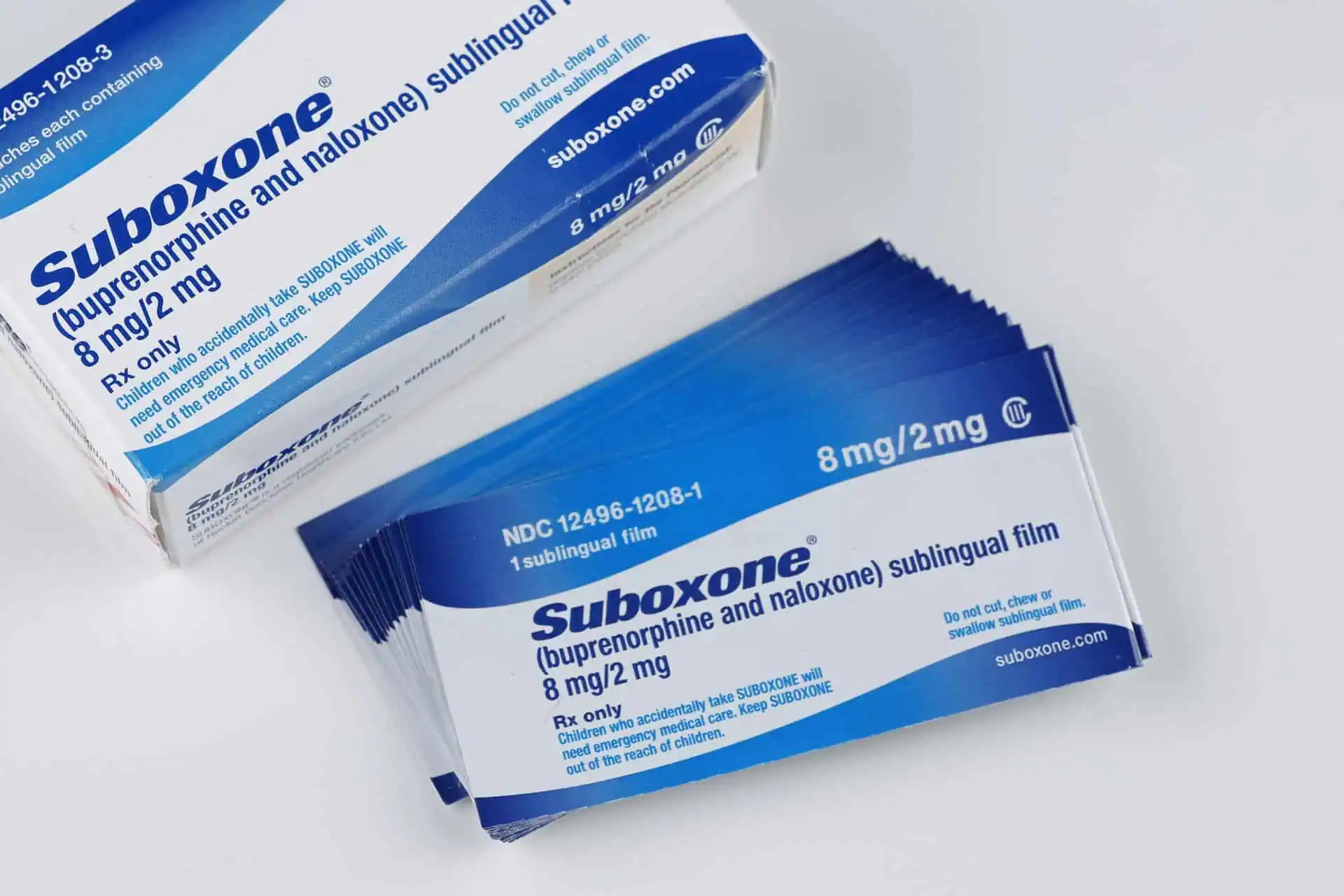Suboxone Dental Problems: What You Need to Know
- Last Updated: June 12th, 2025

Attorney Jessica Paluch-Hoerman, founder of TruLaw, has over 28 years of experience as a personal injury and mass tort attorney, and previously worked as an international tax attorney at Deloitte. Jessie collaborates with attorneys nationwide — enabling her to share reliable, up-to-date legal information with our readers.
Legally Reviewed
This article has been written and reviewed for legal accuracy and clarity by the team of writers and legal experts at TruLaw and is as accurate as possible. This content should not be taken as legal advice from an attorney. If you would like to learn more about our owner and experienced injury lawyer, Jessie Paluch, you can do so here.
Fact-Checked
TruLaw does everything possible to make sure the information in this article is up to date and accurate. If you need specific legal advice about your case, contact us by using the chat on the bottom of this page. This article should not be taken as advice from an attorney.
Key takeaways:
- Suboxone effectively treats opioid addiction by reducing cravings and withdrawal symptoms, but its use has been linked to an increased risk of dental problems like tooth decay, oral infections, and tooth loss.
- Proper oral hygiene practices, regular dental check-ups, and open communication with healthcare providers are essential for minimizing dental risks associated with Suboxone treatment.
- The FDA has issued warnings and implemented measures such as updated labeling, medication guides, and prescriber education to address the potential dental health concerns related to Suboxone use.
Overview of Suboxone Dental Problems
On this page, we’ll discuss Suboxone dental problems, types of dental issues linked to Suboxone use, how to seek treatment for Suboxone dental problems, and much more.
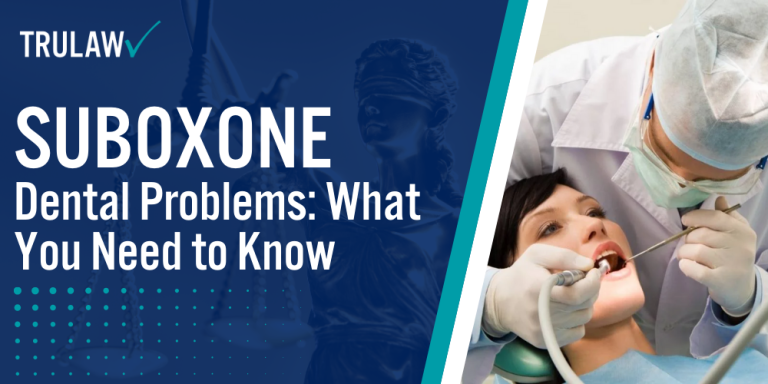
Intro to Suboxone Dental Problems
Some of the common Suboxone dental problems include, but are not limited to:
- Tooth Decay and Cavities: Suboxone films can contribute to tooth decay and cavities due to their acidic properties and the potential for prolonged contact with teeth.
- Enamel Erosion: The acidic nature of Suboxone films can erode tooth enamel, making teeth more susceptible to decay and sensitivity.
- Gum Recession and Inflammation: Suboxone use may lead to gum recession and inflammation, progressing to more severe forms of gum disease if left untreated.
- Oral Infections and Sores: Suboxone films can alter the oral environment, increasing the risk of oral infections and sores, such as thrush or mouth ulcers.
If you have experienced dental problems after using Suboxone sublingual films, it’s important to seek dental care and explore your legal options for compensation.
Contact TruLaw using the chat on this page for a free consultation to discuss your Suboxone-related dental problems and potential legal recourse.
Table of Contents
Risks and Benefits of Suboxone for Opioid Use Disorder
Suboxone, a medication combining buprenorphine and naloxone, is widely recognized for its effectiveness in treating opioid dependence.
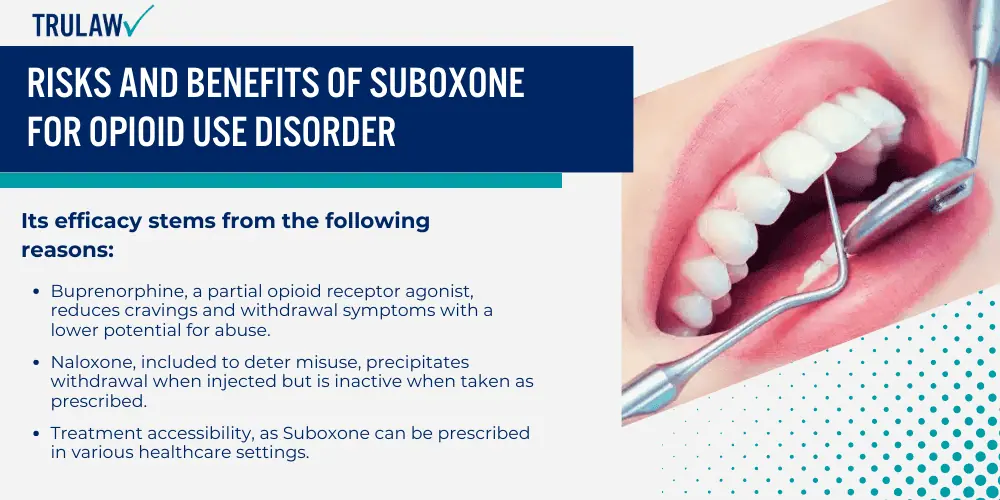
This section examines the advantages and potential dental consequences associated with Suboxone treatment.
Importance of Suboxone in Treating Opioid Addiction
Suboxone plays a vital role in the management of opioid addiction by mitigating withdrawal symptoms and curbing the urge to misuse opioids.
Its efficacy stems from the following reasons:
- Buprenorphine, a partial opioid receptor agonist, reduces cravings and withdrawal symptoms with a lower potential for abuse.
- Naloxone, included to deter misuse, precipitates withdrawal when injected but is inactive when taken as prescribed.
- Treatment accessibility, as Suboxone can be prescribed in various healthcare settings.
- It serves as a harm-reduction strategy, lowering the risk of overdose and other complications related to opioid misuse.
Weighing the Benefits and Risks of Suboxone Treatment
Understanding the balance between the benefits and associated risks of Suboxone is essential for patients and healthcare providers.
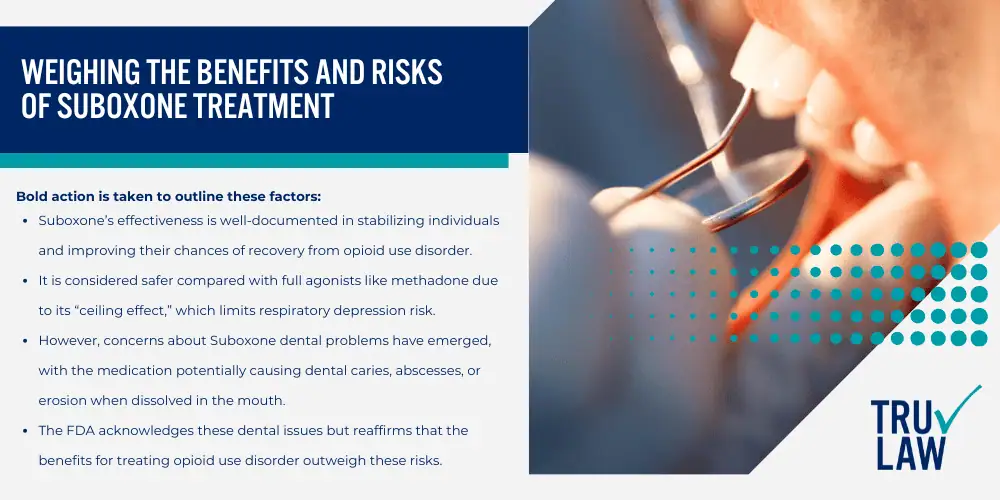
Bold action is taken to outline these factors:
- Suboxone’s effectiveness is well-documented in stabilizing individuals and improving their chances of recovery from opioid use disorder.
- It is considered safer compared with full agonists like methadone due to its “ceiling effect,” which limits respiratory depression risk.
- However, concerns about Suboxone dental problems have emerged, with the medication potentially causing dental caries, abscesses, or erosion when dissolved in the mouth.
- The FDA acknowledges these dental issues but reaffirms that the benefits for treating opioid use disorder outweigh these risks.
Types of Dental Problems Associated with Suboxone
Suboxone use has been linked to a range of dental problems.
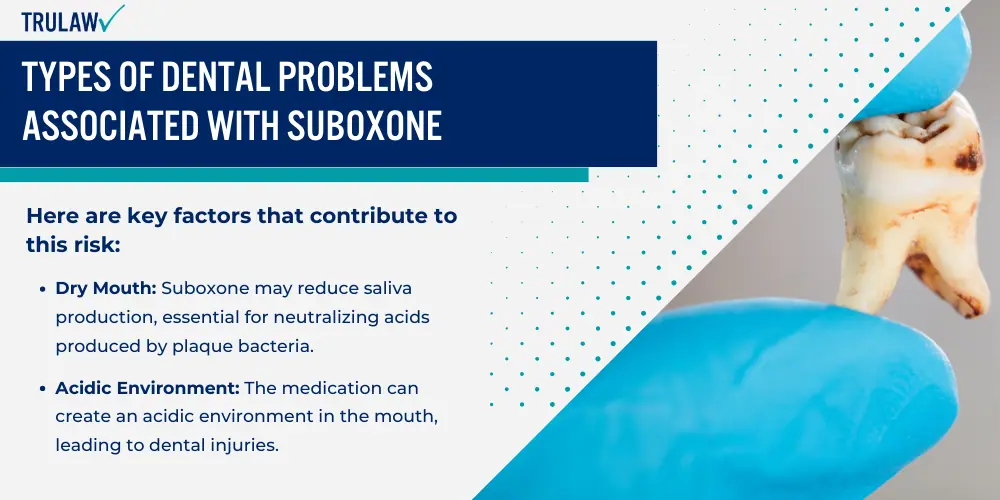
Patients may experience oral health issues from extended use, particularly those related to tooth decay and oral infections.
Tooth Decay and Cavities Linked to Suboxone Use
Patients taking Suboxone can experience an increased risk of tooth decay and cavities.
Here are key factors that contribute to this risk:
- Dry Mouth: Suboxone may reduce saliva production, essential for neutralizing acids produced by plaque bacteria.
- Acidic Environment: The medication can create an acidic environment in the mouth, leading to dental injuries.
- Neglected Oral Hygiene: Patients with substance use disorder might neglect their oral health, exacerbating the development of dental caries.
- Long-Term Usage: Prolonged exposure to the medication can result in more severe forms of advanced tooth decay.
Oral Infections and Tooth Loss in Suboxone Patients
Oral infections and tooth loss represent some of the more severe consequences of using Suboxone.
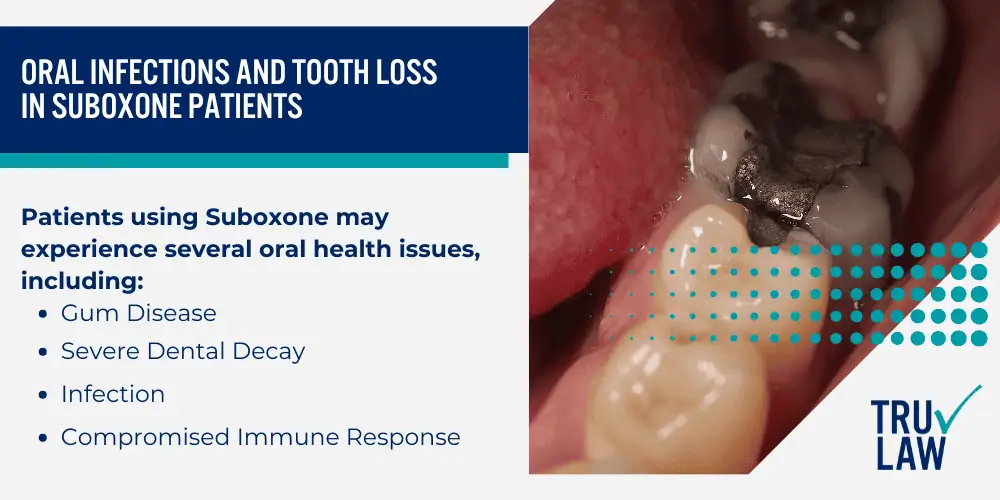
Patients using Suboxone may experience several oral health issues, including:
- Gum Disease: Decreased protective saliva and poor oral hygiene can advance gum disease, leading to tooth loss.
- Severe Dental Decay: Untreated cavities can deteriorate, whereas severe tooth decay forces the removal of affected teeth.
- Infection: Open cavities can become gateways for infection, potentially affecting underlying bone and leading to tooth loss.
- Compromised Immune Response: Substance use can impair the body’s immune response, making it harder to combat oral infections.
Factors Contributing to Suboxone-Related Dental Issues
Suboxone-related dental Issues could stem from both the medication’s formulation and a patient’s prior dental health.
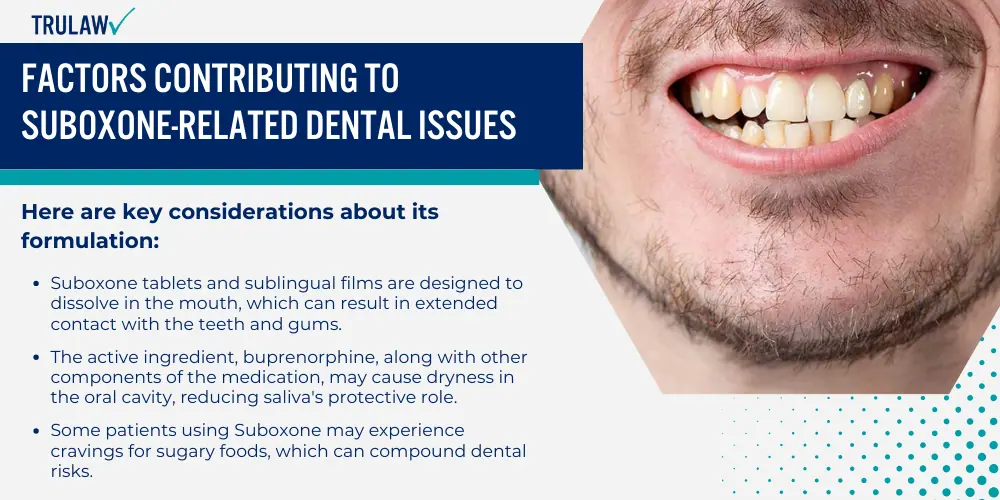
It’s important to understand how these elements can affect oral health.
Role of Suboxone Formulation in Dental Problems
Suboxone, particularly when dissolved in the mouth, can increase the risk of worsening dental health issues.
Here are key considerations about its formulation:
- Suboxone tablets and sublingual films are designed to dissolve in the mouth, which can result in extended contact with the teeth and gums.
- The active ingredient, buprenorphine, along with other components of the medication, may cause dryness in the oral cavity, reducing saliva’s protective role.
- Some patients using Suboxone may experience cravings for sugary foods, which can compound dental risks.
- There are ongoing discussions about Suboxone product liability lawsuits, where oral health damage is cited due to the medication’s use.
Patient Dental History and Suboxone Dental Risks
A patient’s dental history is vital in how buprenorphine medicines impact their oral health.
Consider these points:
- A previously poor dental hygiene routine can increase the likelihood of complications when on Suboxone therapy.
- Those with a history of good dental health can still face problems, as the buprenorphine medicine may exacerbate otherwise minor issues.
- Patients on buprenorphine medicines dissolved in the mouth should be vigilant about oral care and regular dental check-ups.
- The intersection of prior dental issues and dental risks associated with Suboxone requires careful attention to prevent further oral health deterioration.
Prevention and Management of Suboxone Dental Problems
Proper oral care and regular dental check-ups are essential for managing oral health for patients using prescription suboxone film.
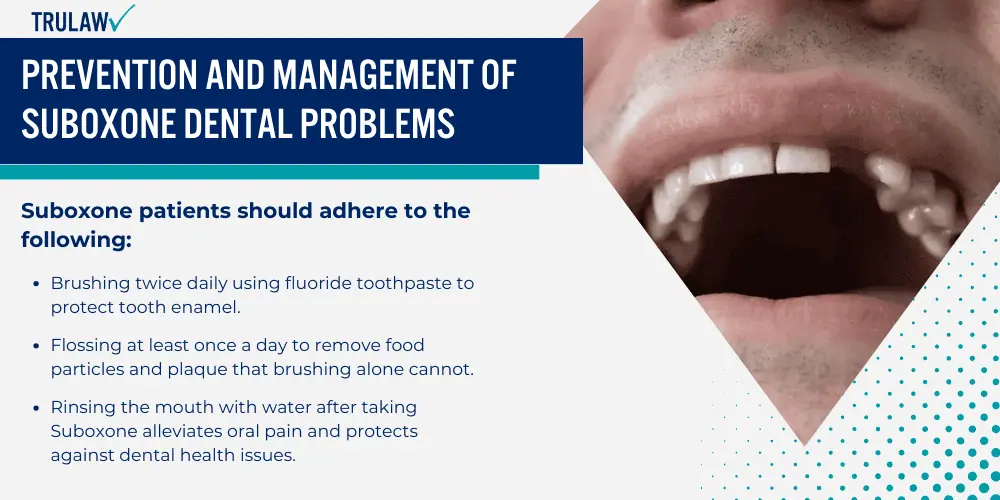
These steps can help prevent and manage potential dental health issues, including tooth enamel damage and more serious problems.
Proper Oral Care Techniques for Suboxone Patients
Good oral hygiene is foundational for Suboxone patients to avoid poor dental health.
Suboxone patients should adhere to the following:
- Brushing twice daily using fluoride toothpaste to protect tooth enamel.
- Flossing at least once a day to remove food particles and plaque that brushing alone cannot.
- Rinsing the mouth with water after taking Suboxone alleviates oral pain and protects against dental health issues.
- Using an antiseptic mouthwash to help prevent infections that contribute to oral health problems.
Regular Dental Check-ups and Preventive Measures
Regular dental visits are key in the early detection and management of potential problems.
Suboxone patients are encouraged to:
- Schedule regular dental checkups, ideally every six months, to monitor for any signs of poor dental health.
- Discuss with their dentist the use of prescription Suboxone film and its implications for dental care.
- Be vigilant for any signs of oral pain or health problems and seek dental care promptly if they occur.
- Consider fluoride varnish or other extensive dental treatments as preventive measures against tooth decay.
Importance of Continuing Suboxone Treatment
Maintaining Suboxone treatment is vital for individuals managing opioid addiction.
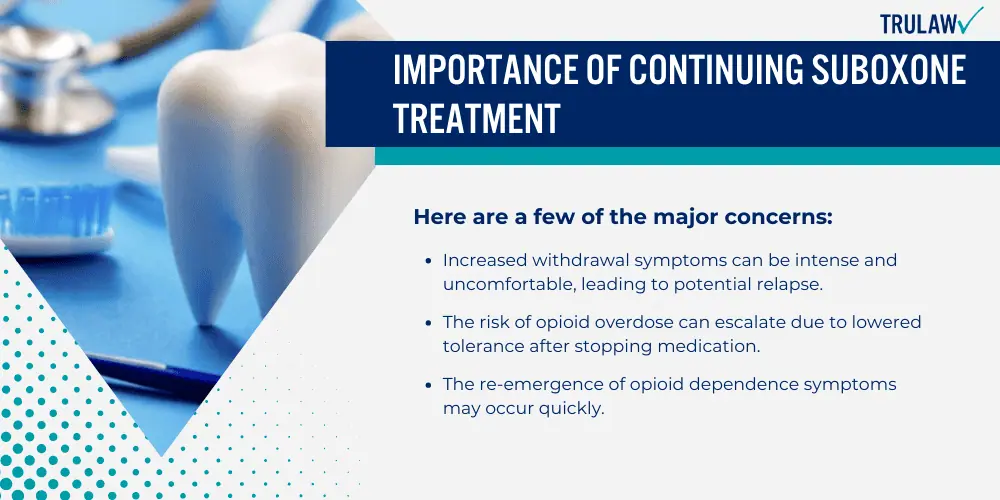
Proper adherence to medication regimens can mitigate withdrawal symptoms and sustain recovery progress.
Risks of Abruptly Stopping Suboxone Medication
Stopping Suboxone suddenly can lead to severe health risks.
Here are a few of the major concerns:
- Increased withdrawal symptoms can be intense and uncomfortable, leading to potential relapse.
- The risk of opioid overdose can escalate due to lowered tolerance after stopping medication.
- The reemergence of opioid dependence symptoms may occur quickly.
- Psychological stress may intensify, complicating the treatment of opioid use disorder.
Balancing Dental Concerns with Opioid Addiction Treatment
When dental problems arise, it’s essential to balance them with the need for continuous treatment.
Consider the following steps:
- Regular dental check-ups and good oral hygiene can prevent severe dental issues.
- Discussing alternative administration methods of Suboxone with a healthcare provider may reduce oral side effects.
- Taking Suboxone as a physician-prescribed suboxone film minimizes the risks of dental complications related to improper use.
- Educating patients on the importance of maintaining dental health and addiction treatment contributes to better overall health outcomes.
Communicating with Healthcare Providers About Suboxone Dental Problems
Effective communication with healthcare providers is essential for managing Suboxone dental problems.
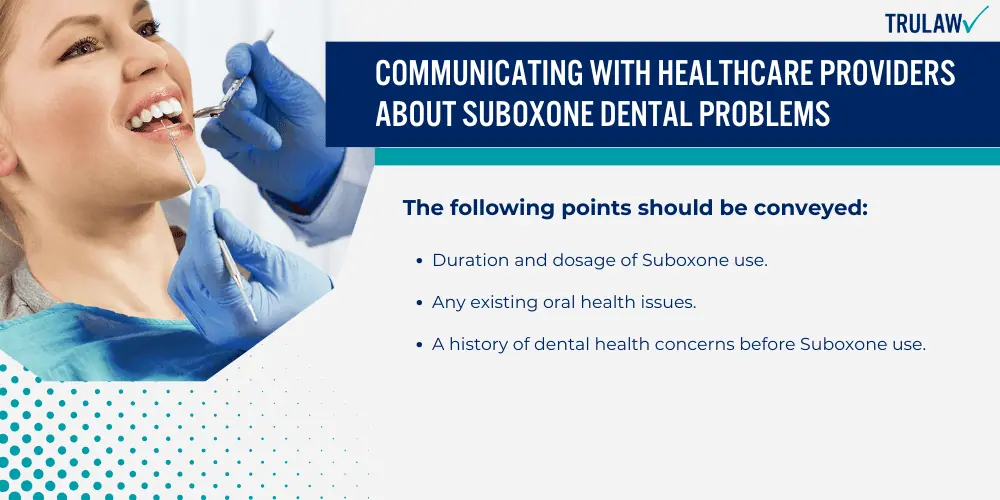
This involves informing them about Suboxone use and ensuring coordinated care to address potential oral health issues.
Informing Doctors and Dentists About Suboxone Use
Patients must be forthright with their healthcare providers about their Suboxone use.
This is because Suboxone has the potential to cause dental problems.
The following points should be conveyed:
- Duration and dosage of Suboxone use.
- Any existing oral health issues.
- A history of dental health concerns before Suboxone use.
Being transparent allows doctors and dentists to develop a comprehensive treatment plan.
This plan addresses both prescription drug dependency and oral health maintenance.
Coordinating Care Between Medical and Dental Professionals
Cooperation between medical practitioners and dental care providers is critical to protecting patients’ oral and overall health.
Key steps include:
- Sharing health records relevant to Suboxone treatment and dental history.
- Discussing potential risks to dental health.
- Monitoring any changes in oral health throughout Suboxone treatment.
- Adhering to guidance from the Food and Drug Administration (FDA) regarding the risks of Suboxone dissolving in the mouth.
The FDA has noted the importance of this interdisciplinary approach.
It helps mitigate the risk of serious dental problems from Suboxone.
By working together, healthcare providers can ensure a balanced treatment paradigm that safeguards mental and dental health.
Suboxone Dental Problem Warning and Patient Recommendations
Recent developments highlight the importance of awareness regarding dental problems associated with Suboxone, a medication commonly used to treat opioid addiction.
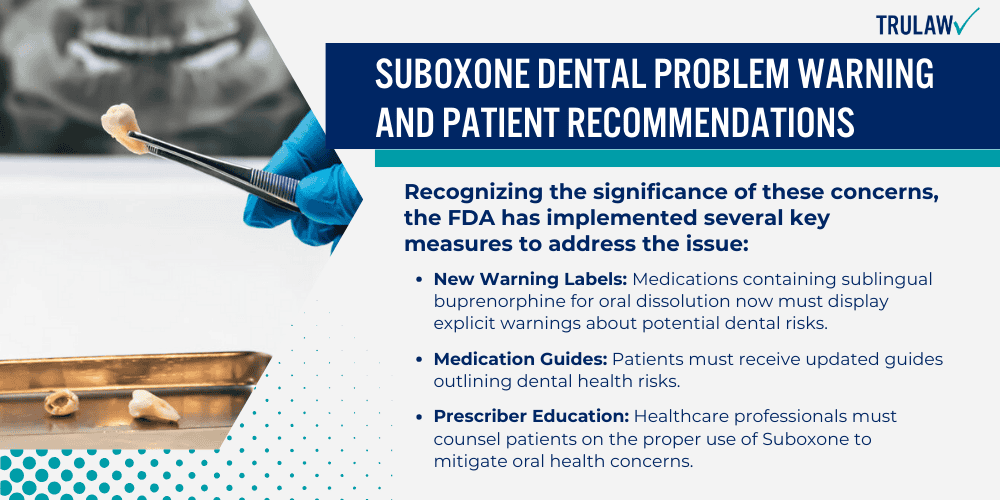
The concerns involve the method of Suboxone administration and the resulting oral health issues.
FDA Requirements for Suboxone Dental Problem Warnings
The U.S. Food and Drug Administration (FDA) has issued warnings regarding Suboxone-related dental issues.
This was after adverse event reports indicated dental problems among users.
Recognizing the significance of these concerns, the FDA has implemented several key measures to address the issue:
- New Warning Labels: Medications containing sublingual buprenorphine for oral dissolution now must display explicit warnings about potential dental risks.
- Medication Guides: Patients must receive updated guides outlining dental health risks.
- Prescriber Education: Healthcare professionals must counsel patients on the proper use of Suboxone to mitigate oral health concerns.
- Reporting Protocols: The FDA has mandated reporting any dental adverse events associated with Suboxone, fostering transparency and monitoring.
Patient Guidelines for Minimizing Suboxone Dental Risks
To minimize the risk of dental problems while using Suboxone, patients should adhere to guidelines addressing oral care.
When it comes to managing dental risks while using Suboxone, it is important to follow these guidelines:
- Oral Hygiene Practices: Brush and floss regularly to maintain good oral hygiene, being mindful of proper techniques.
- Rinsing After Medication: After completely dissolved in the mouth, gently rinse with water to remove any residue that could affect dental health.
- Regular Dental Checkups: Schedule routine dental exams and cleanings, and inform the dentist about initiating buprenorphine treatment.
- Report Dental Changes: Should any dental issues arise, it is essential to report these adverse events to a healthcare provider promptly.
Suboxone Lawsuit Frequently Asked Questions
-
What legal actions are patients who experienced tooth decay from Suboxone taking?
Patients have been reporting dental problems such as tooth decay after using Suboxone, leading some to consider legal recourse.
Law firms specializing in Suboxone tooth decay litigation discuss potential claims for compensation related to these dental issues.
-
What are common dental issues reported by Suboxone users?
Suboxone users have reported experiencing a range of dental issues, such as tooth decay, oral infections, cavities, and tooth loss.
These occurrences have been associated with the presence of buprenorphine-naloxone, which is a component of the medication that must be dissolved in the mouth.
-
How does buprenorphine potentially lead to tooth decay?
Buprenorphine’s method of administration—dissolving in the mouth—can reduce saliva production, which is a key factor in neutralizing acids and protecting teeth.
The decreased saliva flow can lead to an environment where tooth decay is more likely to develop.
-
What should patients know about the new dental warning for buprenorphine?
The FDA has issued a warning about the risk of dental problems linked to buprenorphine.
Patients should be aware that even those without a history of dental issues may experience tooth decay, cavities, and other serious dental conditions as a side effect.
-
What legal actions are taken by patients who experience tooth decay from taking Suboxone?
Patients who have experienced tooth decay from Suboxone may consider taking legal action by filing a Suboxone tooth decay lawsuit.
These lawsuits, often called “Suboxone tooth decay lawsuits,” aim to seek compensation for the dental issues caused by the medication.
Patients can consult with law firms specializing in Suboxone tooth decay litigation to understand their legal options and pursue a claim.
-
What are common dental issues reported by Suboxone users?
Suboxone users have reported various dental issues, including tooth decay, cavities, oral infections, and tooth loss.
These dental problems are often associated with the formulation of Suboxone, which requires the medication to be dissolved in the mouth.
The presence of buprenorphine-naloxone in Suboxone can contribute to these dental issues, leading some users to consider filing “Suboxone teeth lawsuits” seeking compensation for their dental problems.

Managing Attorney & Owner
With over 25 years of legal experience, Jessica Paluch-Hoerman is an Illinois lawyer, a CPA, and a mother of three. She spent the first decade of her career working as an international tax attorney at Deloitte.
In 2009, Jessie co-founded her own law firm with her husband – which has scaled to over 30 employees since its conception.
In 2016, Jessie founded TruLaw, which allows her to collaborate with attorneys and legal experts across the United States on a daily basis. This hypervaluable network of experts is what enables her to share the most reliable, accurate, and up-to-date legal information with our readers!
Additional Suboxone Lawsuit resources on our website:
Here, at TruLaw, we’re committed to helping victims get the justice they deserve.
Alongside our partner law firms, we have successfully collected over $3 Billion in verdicts and settlements on behalf of injured individuals.
Would you like our help?
At TruLaw, we fiercely combat corporations that endanger individuals’ well-being. If you’ve suffered injuries and believe these well-funded entities should be held accountable, we’re here for you.
With TruLaw, you gain access to successful and seasoned lawyers who maximize your chances of success. Our lawyers invest in you—they do not receive a dime until your lawsuit reaches a successful resolution!
AFFF Lawsuit claims are being filed against manufacturers of aqueous film-forming foam (AFFF), commonly used in firefighting.
Claims allege that companies such as 3M, DuPont, and Tyco Fire Products failed to adequately warn users about the potential dangers of AFFF exposure — including increased risks of various cancers and diseases.
Depo Provera Lawsuit claims are being filed by individuals who allege they developed meningioma (a type of brain tumor) after receiving Depo-Provera birth control injections.
A 2024 study found that women using Depo-Provera for at least 1 year are five times more likely to develop meningioma brain tumors compared to those not using the drug.
Suboxone Tooth Decay Lawsuit claims are being filed against Indivior, the manufacturer of Suboxone, a medication used to treat opioid addiction.
Claims allege that Indivior failed to adequately warn users about the potential dangers of severe tooth decay and dental injuries associated with Suboxone’s sublingual film version.
Social Media Harm Lawsuits are being filed against social media companies for allegedly causing mental health issues in children and teens.
Claims allege that companies like Meta, Google, ByteDance, and Snap designed addictive platforms that led to anxiety, depression, and other mental health issues without adequately warning users or parents.
Transvaginal Mesh Lawsuits are being filed against manufacturers of transvaginal mesh products used to treat pelvic organ prolapse (POP) and stress urinary incontinence (SUI).
Claims allege that companies like Ethicon, C.R. Bard, and Boston Scientific failed to adequately warn about potential dangers — including erosion, pain, and infection.
Bair Hugger Warming Blanket Lawsuits involve claims against 3M — alleging their surgical warming blankets caused severe infections and complications (particularly in hip and knee replacement surgeries).
Plaintiffs claim 3M failed to warn about potential risks — despite knowing about increased risk of deep joint infections since 2011.
Baby Formula NEC Lawsuit claims are being filed against manufacturers of cow’s milk-based baby formula products.
Claims allege that companies like Abbott Laboratories (Similac) and Mead Johnson & Company (Enfamil) failed to warn about the increased risk of necrotizing enterocolitis (NEC) in premature infants.
Here, at TruLaw, we’re committed to helping victims get the justice they deserve.
Alongside our partner law firms, we have successfully collected over $3 Billion in verdicts and settlements on behalf of injured individuals.
Would you like our help?
